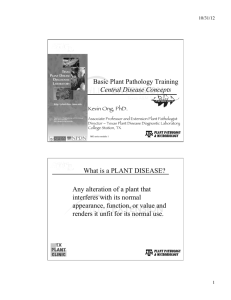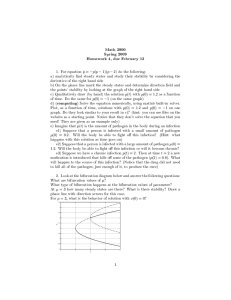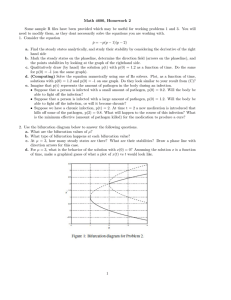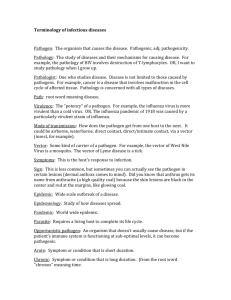Pathogen frequency in an age-structured population of Plantago lanceolata
advertisement
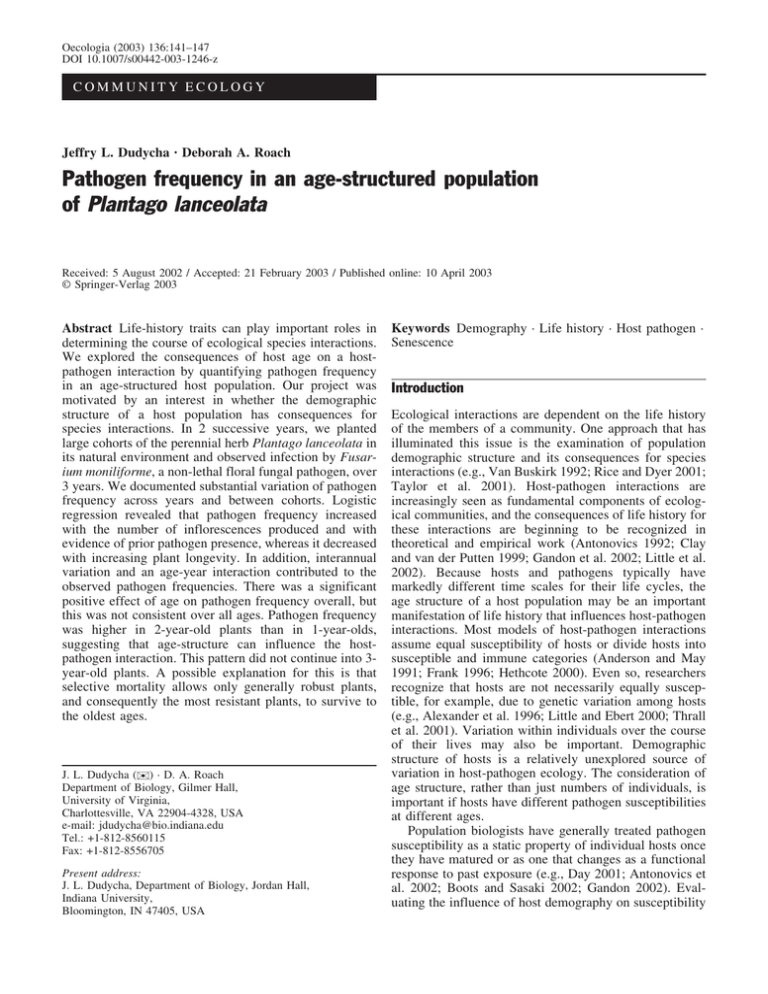
Oecologia (2003) 136:141–147 DOI 10.1007/s00442-003-1246-z COMMUNITY ECOLOGY Jeffry L. Dudycha · Deborah A. Roach Pathogen frequency in an age-structured population of Plantago lanceolata Received: 5 August 2002 / Accepted: 21 February 2003 / Published online: 10 April 2003 Springer-Verlag 2003 Abstract Life-history traits can play important roles in determining the course of ecological species interactions. We explored the consequences of host age on a hostpathogen interaction by quantifying pathogen frequency in an age-structured host population. Our project was motivated by an interest in whether the demographic structure of a host population has consequences for species interactions. In 2 successive years, we planted large cohorts of the perennial herb Plantago lanceolata in its natural environment and observed infection by Fusarium moniliforme, a non-lethal floral fungal pathogen, over 3 years. We documented substantial variation of pathogen frequency across years and between cohorts. Logistic regression revealed that pathogen frequency increased with the number of inflorescences produced and with evidence of prior pathogen presence, whereas it decreased with increasing plant longevity. In addition, interannual variation and an age-year interaction contributed to the observed pathogen frequencies. There was a significant positive effect of age on pathogen frequency overall, but this was not consistent over all ages. Pathogen frequency was higher in 2-year-old plants than in 1-year-olds, suggesting that age-structure can influence the hostpathogen interaction. This pattern did not continue into 3year-old plants. A possible explanation for this is that selective mortality allows only generally robust plants, and consequently the most resistant plants, to survive to the oldest ages. J. L. Dudycha ()) · D. A. Roach Department of Biology, Gilmer Hall, University of Virginia, Charlottesville, VA 22904-4328, USA e-mail: jdudycha@bio.indiana.edu Tel.: +1-812-8560115 Fax: +1-812-8556705 Present address: J. L. Dudycha, Department of Biology, Jordan Hall, Indiana University, Bloomington, IN 47405, USA Keywords Demography · Life history · Host pathogen · Senescence Introduction Ecological interactions are dependent on the life history of the members of a community. One approach that has illuminated this issue is the examination of population demographic structure and its consequences for species interactions (e.g., Van Buskirk 1992; Rice and Dyer 2001; Taylor et al. 2001). Host-pathogen interactions are increasingly seen as fundamental components of ecological communities, and the consequences of life history for these interactions are beginning to be recognized in theoretical and empirical work (Antonovics 1992; Clay and van der Putten 1999; Gandon et al. 2002; Little et al. 2002). Because hosts and pathogens typically have markedly different time scales for their life cycles, the age structure of a host population may be an important manifestation of life history that influences host-pathogen interactions. Most models of host-pathogen interactions assume equal susceptibility of hosts or divide hosts into susceptible and immune categories (Anderson and May 1991; Frank 1996; Hethcote 2000). Even so, researchers recognize that hosts are not necessarily equally susceptible, for example, due to genetic variation among hosts (e.g., Alexander et al. 1996; Little and Ebert 2000; Thrall et al. 2001). Variation within individuals over the course of their lives may also be important. Demographic structure of hosts is a relatively unexplored source of variation in host-pathogen ecology. The consideration of age structure, rather than just numbers of individuals, is important if hosts have different pathogen susceptibilities at different ages. Population biologists have generally treated pathogen susceptibility as a static property of individual hosts once they have matured or as one that changes as a functional response to past exposure (e.g., Day 2001; Antonovics et al. 2002; Boots and Sasaki 2002; Gandon 2002). Evaluating the influence of host demography on susceptibility 142 requires us to view susceptibility as a quantitative property that can change within individual hosts for reasons other than exposure. One source of changing host susceptibility may be physiological aging. As adult organisms grow older, they are subject to a general deterioration of their capabilities, known as aging or senescence, whose effects may include increasing pathogen susceptibility (Finch 1990). Life-history biologists have been placing increasing emphasis on aging in the context of evolutionary ecology because it provides a framework for integrating information about the whole life cycle (Roach 1993, 2003a, 2003b; Tatar et al. 1997; Dudycha 2001). Although the majority of empirical work has been with animals, plants should be subject to the same evolutionary processes that lead to the evolution of aging (Roach 1993, 2003b). Demographically, senescent declines can be found in both annual and perennial species (Watkinson 1992; Roach 1993; Pedersen 1999). Plant systems are ideal for investigating the interaction between host age-structure and pathogen susceptibility because individuals can be reliably tracked over time in a natural setting. We sought to test the hypothesis that pathogen frequency increases with advancing host age. We conducted a large demographic experiment tracking experimental cohorts of Plantago lanceolata in its natural environment (Roach 2003a). During the course of the experiment, we observed whether inflorescences were infected with Fusarium moniliforme, a common fungal pathogen. By observing differently aged cohorts across years, we were able to separate the effects of age from interannual variability of pathogen frequency, while accounting for growth and previous infection. We examined effects of host age on pathogen frequency both within and across years. Because selective mortality allows only particularly vigorous individuals to live until old ages, and because these individuals may also be particularly resistant to pathogens, our secondary objective was to test whether host longevity was related to pathogen frequency. Plantago lanceolata L. (Plantaginaceae) is a widespread, small, self-incompatible perennial herb that primarily inhabits mown fields and roadsides. At our study site (described in Fowler and Antonovics 1981; Antonovics et al. 1988; Roach 2003a), it flowers from May through early September, producing multiple inflorescences over the course of the summer. Most individuals (>90%) die within 4 years (Roach 2003a). P. lanceolata is susceptible to the fungal pathogen Fusarium moniliforme var. subglutinans Wr. and Reink, which can infect the surface of inflorescences throughout the flowering season. The pathogen remains dormant through the winter, persisting on the ground and on dead, fallen inflorescences, and is probably splash dispersed (Alexander 1982). Infection by F. moniliforme reduces seed set of an infected inflorescence by preventing maturation of some of its seeds; consequently, there may be selection favoring resistant hosts (Alexander 1982). F. moniliforme is not a systemic or lethal disease. Microscopic examination has revealed that the fungus does not invade vascular tissue (Alexander 1982), and individuals that are infected one year need not be infected subsequently (Alexander et al. 1984; personal observations). Materials and methods Cohorts of P. lanceolata were planted in a field in Durham, N.C., USA in April of 1997 and 1998, and incidence of F. moniliforme was tracked for 3 years, yielding both longitudinal and crosssectional data on pathogen frequency. The experimental population was established with seed obtained from 120 plants within 1.5 m on either side of two 25-m transects across the same field where the seedlings were eventually planted. Details on the planting procedures and demography of these cohorts are reported elsewhere (Roach 2003a). Cohorts were initially composed of 10,000 6-weekold seedlings raised in the National Phytotron greenhouse at Duke University. Plants reached maturity 1 year after being planted in the field, but many died prior to maturation, especially in cohort 2 (Roach 2003a). Our observations continued through October 2001, when the experiment was prematurely terminated because the field site became unavailable. Two additional cohorts were planted, in 1999 and 2000, as part of a long-term demography study (Roach 2003a), but neither of these later cohorts is used here. Cohort 3 had few individuals survive to maturity, and cohort 4 flowered for the first time in 2001. Fusarium moniliforme is easily identified on P. lanceolata by a pink, cottony mycelium that grows on the inflorescence (Alexander 1982). Inflorescences were periodically harvested and examined for infection, approximately biweekly, throughout the flowering season (July–September) after their seeds had matured (indicated by a completely dried stalk). Most plants produce inflorescences repeatedly throughout the flowering season. A plant was considered infected if any inflorescence, at any time in the flowering season, was infected by F. moniliforme to any degree (Alexander et al. 1984). Since plants that produce more inflorescences have more opportunities to be infected, we included the number of inflorescences produced by a plant as a covariate in all analyses. Observed Fusarium frequencies were extremely low in 2001 (Fig. 1), precluding the sensitivity necessary to analyze differences among cohorts. Consequently, we limited our analysis to observations on cohorts 1 and 2 from 1998–2000. The two cohorts produced a total of 5,213 observations of flowering over 3 years on 3,669 different individuals (Table 1). Although spatial heterogene- Fig. 1 Frequency of Fusarium moniliforme infection in cohorts of Plantago lanceolata. Error bars indicate 95% confidence intervals estimated from the binomial distribution 143 Table 1 Number of plants flowering in each year Year Cohort 1 Cohort 2 Sum 1998 1999 2000 Total observations Total individuals 2,648 897 820 4,365 3,155 368 480 848 514 2,648 1,265 1,300 5,213 3,669 ity in F. moniliforme has been reported (Alexander 1984), it is beyond the scope of this paper, and we consequently assume that all host individuals had an equal probability of exposure to the pathogen. We analyzed our results with multiple logistic regression (SAS v. 8, Proc Logistic), since we defined infection status as a binomial variable (an individual plant was either infected or not in a given year). Multiple logistic regression allowed us to simultaneously test effects of several independent variables on a binomial response (Agresti 1996). We viewed years as a categorical variable sampling the interannual variability of pathogen frequency. Therefore, we defined year as a class variable in Proc Logistic, which then provides parameter estimates with respect to the average across years. Variation in weather patterns would be a logical source of interannual pathogen variation; however, there was no relationship whatsoever (across 1998–2001) between mean monthly temperature or precipitation and pathogen frequency, either for the months during flowering or for the months preceding flowering (D.A.R., unpublished data), so we did not include these in the analysis. In effect, we are treating years as blocks in time, with an unknown mechanism of influence on pathogen frequency. We needed to account for the fact that we made repeated observations on individual plants. Although F. moniliforme is not systemic, once we observed that an individual was or was not infected, we had information on its susceptibility. Furthermore, Alexander et al. (1984) reported that plants with a history of infection were more likely to be infected than plants with no prior infection. To address this issue, we used a general procedure for dependent observations in logistic regression (Bonney 1987). This allowed us to incorporate the repeated nature of observations with a pathogen history variable, where each observation is classified as “no data in previous year” (because the plant did not flower), “infected the previous year,” or “flowered, but not infected the previous year.” In a more complex model, we sought to incorporate information about an individual plant’s overall robustness, since robustness may be correlated with pathogen resistance and selection may leave only the most robust individuals alive at the oldest ages. Plant longevity is a directly relevant indicator of robustness, and we defined it as the number of flowering seasons for which an individual was alive at the beginning of the flowering season. This was taken from census information as of October 2001 (data not shown; see Roach 2003a). Plants were classified as having a longevity of 1, 2, or 3+ years, because we do not know how much longer plants alive at the termination of the experiment would have lived. Results The frequency of F. moniliforme infection varied strongly between cohorts of P. lanceolata and among years (Fig. 1). In 1998, the first year cohort 1 flowered, 7.85% of flowering plants were infected by F. moniliforme. In 1999, pathogen frequency more than tripled for cohort 1 to 33.89%. Cohort 2 also had a high pathogen frequency in 1999 (25.27%), but not as high as the older cohort 1. In 2000, pathogen frequency in cohort 1 Fig. 2 Number of inflorescences produced by individual plants during each flowering season. Solid box plots are cohort 1; dashed box plots are cohort 2. The gray box plot in 2001 represents an additional cohort planted in 2000. Data shown are ln-transformed declined relative to the prior year to 25.85%. In contrast, pathogen frequency in cohort 2 increased (to 37.5%), relative to both the prior year and the older cohort 1. As noted above, pathogen frequency was dramatically lower in both cohorts in 2001 (1.9% and 1.1%, respectively) and was also low in the new cohort (4) planted the previous year (2.7%). Much of the variation among years and cohorts could be due to the number of inflorescences our experimental individuals produced, because we scored plants based on whether any inflorescence was infected. Consequently, we include the number of inflorescences as a covariate in our analyses and presentation of the data in order to obtain unconfounded estimates of the effects of other factors. Within cohorts, there were more inflorescences per plant each year until 2001, when there was a slight decline relative to 2000 (Fig. 2). However, within years, older plants did not necessarily produce more inflorescences. In 1999, both cohorts had similar numbers of inflorescences despite their difference in age (t =–0.0070, df =701.3, P=0.9945; cohort 1: mean = 10.2€0.3 SE inflorescences/plant, med = 7; cohort 2: mean = 10.1€0.5, med = 8). Furthermore, in 2000, individuals of the younger cohort produced notably more inflorescences than did the older cohort (t =–6.6683, df =1123.0, P<0.0001; cohort 1: mean = 17.5€0.6 SE inflorescences/plant, med = 12; cohort 2: mean = 21.7€0.8, med = 18). Pathogen frequency increased with inflorescence number, but this variation does not account for all of the differences among years and between cohorts (Fig. 3, Table 2). The basic logistic regression model revealed a significant increase in pathogen frequency with increasing inflorescence number and with previous infection, as well as a significant effect of year (Table 2). No significant effect of age was found, possibly because the effect of age varied among years or was non-monotonic. We used two approaches to explore this further. First, we added an ageyear interaction to the logistic regression model. This addresses, for example, whether the difference between age 1 and age 2 depends on the year in which the ages are 144 Table 2 Summary of effects on Fusarium moniliforme frequency in Plantago lanceolata for all ages and years combined. Positive estimates for “prior infection” indicate that plants infected in the previous year are more likely to be infected than other plants in the Parameter Intercept No. inflorescences Year 1998 1999 2000 Prior infection Age Age Year Longevity Base model current year. “Year” is treated as a class variable; therefore, parameter estimates for specific years are listed below the overall effect of year. A positive estimate indicates greater pathogen frequency than the average across years With age-year interaction c P Estimate c P Estimate c2 P –1.9490 0.0451 114.41 172.56 209.25 73.23 166.76 1.60 24.60 0.34 <0.0001 <0.0001 <0.0001 <0.0001 <0.0001 0.2054 <0.0001 0.5597 –3.0042 0.0443 113.36 165.22 202.03 97.21 188.99 14.51 33.10 16.49 26.07 <0.0001 <0.0001 <0.0001 <0.0001 <0.0001 0.0001 <0.0001 <0.0001 <0.0001 –2.7720 0.0446 89.54 166.88 187.35 105.50 173.32 13.66 33.62 23.14 24.73 8.82 <0.0001 <0.0001 <0.0001 <0.0001 <0.0001 0.0002 <0.0001 <0.0001 <0.0001 0.0029 –1.3074 0.8667 0.4407 0.3737 0.5872 1.00787 Fig. 3 Relationship between number of inflorescences produced and frequency of infection. Top panel shows data for the year 1998, middle for 1999, and bottom for 2000. Sample size is indicated by numbers adjacent to each data point. Cohort 1 is shown with diamonds and solid lines, cohort 2 with circles and dashed lines observed. The interaction model had a significantly better fit to the data than did the model without an age-year interaction (likelihood-ratio test; c2 = 26.55, df =1, P<0.0001) and showed both a significant age-year interaction and a significant increase of pathogen frequency with age (Table 2). Although other interactions 2 With interaction and Longevity Estimate –0.8288 0.6986 0.1302 0.3164 0.0561 2 –1.4136 0.9858 0.4278 0.3770 0.7336 0.9831 –0.1762 are possible, we had insufficient replication (in cohorts and years) to incorporate them in a joint analysis, and the age-year interaction is most relevant to our primary question. Our second approach was to focus specifically on the difference between age 1 and 2 and then to focus on the difference between age 2 and 3 (Table 3). This allowed us to determine whether the effects of aging on pathogen frequency differ qualitatively at different ages. In both cases, age had a significant effect, but it was positive for the difference from age 1 to age 2 (i.e., pathogen frequency increased) and negative for the difference from age 2 to age 3 (i.e., pathogen frequency decreased). Separate analyses on each cohort alone produced the same results (not shown, but see Fig. 1). Thus, the effects of host age structure on pathogen frequency in a population may be more complex than a simple aging model would suggest. Note that although this analysis included data on age 2 from both cohorts, all data for age 3 came from only cohort 1. Consequently, although the age 2 versus 3 comparison allows us to better understand patterns within our data, the generality of the result is limited. Beyond environmental influences, population-level changes in pathogen frequency may be influenced both by internal, physiological changes in individual plants and by changes in the composition of a cohort as individuals die. Successive ages are likely to be composed of a nonrandom subsample of the genetic heterogeneity originally present in the population due to selective mortality. Thus, our observations of pathogen frequency at later ages can be made only on the subset of individuals that survived to that age. This may lead to low pathogen frequencies in the population at the latest ages if robust individuals are both long-lived and particularly resistant to pathogens. For example, for the 1999 data we compared individuals whose ultimate longevity was only 2 years to those that ultimately lived 3 or more years. In both cohorts, longlived plants had lower pathogen frequencies than did the individuals that lived two years (Fig. 4). A logistic regression model incorporating longevity showed a significant negative effect of longevity on pathogen fre- 145 Table 3 Summary of effects from logistic regression on F. moniliforme frequency in P. lanceolata for specific age differences Age 1 compared to age 2 Intercept No. inflorescences Year 1998 1999 2000 Prior infection Age Age 2 compared to age 3 2 Estimate c –2.8165 0.0580 130.40 142.05 78.93 24.43 74.01 0.02 9.92 13.91 –0.5430 0.5583 –0.0153 0.2917 0.5570 Estimate c2 P Intercept No. inflorescences Year –0.1518 0.0355 0.1597 0.24 105.71 6.09 0.6377 <0.0001 0.0131 Prior infection Age 0.3593 –0.4419 31.60 11.49 <0.0001 0.0007 P <0.0001 <0.0001 <0.0001 <0.0001 <0.0001 0.8869 0.0016 0.0002 Table 4 Odds ratios associated with the full logistic regression model Fig. 4 Pathogen frequencies in 1999 for plants with different longevities. Open squares show those plants that lived 2 years; closed triangles show plants that lived 3 or more years. Numbers next to points indicate sample sizes within each inflorescencenumber class quency (Table 2) and had a better fit to the data than did the model without longevity (likelihood-ratio test: c2= 15.32, df =1, P<0.0001). Effects of other parameters in the model incorporating longevity were similar to those in the model without longevity, but the positive effect of age appears to be stronger when longevity is included (Table 2). The analysis indicates that for a particular number of inflorescences in a given year, long-lived plants have a lower probability of infection than do shortlived plants, but also that an individual’s probability of infection changes with age. One approach to comparing the relative consequences of different factors influencing the frequency of pathogen infection is to consider the odds ratio, which specifies the multiplicative change in the odds of infection associated with a one-unit increase in a particular explanatory Variable Odds ratio 95% CI Inflorescences Prior infection Age Longevity 1.046 1.458 2.083 0.838 1.039 1.283 1.544 0.746 1.053 1.656 2.808 0.942 variable (Agresti 1996). By using the full logistic regression model (all data, with age-year interaction and longevity included), we determined the overall odds ratios and their 95% confidence intervals for number of inflorescences, prior infection status, age, and longevity (Table 4). We found that one additional inflorescence increases the odds that an individual is infected by about 5%, being 1 year older approximately doubles the odds relative to other members of the population (driven largely by the difference in odds between age 1 and older), and a 1-year longer lifespan decreases the odds by ~15%. A plant that was previously infected has an odds of being infected that is about 50% greater than that for a plant with no prior information and more than twice that of a previously uninfected plant. Discussion Our data show that age structure of a host can play a substantial role in the frequency of a pathogen in a population under natural conditions. Although we did not observe a simple increase in pathogen frequency with host age, we documented variation of pathogen frequency associated with the host’s age, longevity, and number of inflorescences, in addition to interannual variation and an age-year interaction. Research on the ecology of hostpathogen relationships may therefore be improved by incorporating information on the demographic structure of the host population. Such an effort is not likely to be straightforward, because multiple aspects of demography appear to combine in complex ways to influence pathogen frequency. Our data confirmed the importance of the number of inflorescences and interannual variation, two covariates that may mask age-structure effects in smaller studies. It 146 is not surprising that the data revealed a role for inflorescence number, because F. moniliforme is a floral pathogen and we did not consider the number of inflorescences infected per individual (i.e., the opportunity for infection) in our pathogen scoring. Over the course of the current study, F. moniliforme was most frequent in 1999. The interannual variation we observed was probably influenced by both general ecological conditions for the spread of F. moniliforme and differences in the average number of inflorescences per individual P. lanceolata (e.g., in 1998, there were only young plants with few inflorescences in our study). In a previous study at our field site, Alexander (1982) found that ~10% of individual P. lanceolata were infected by F. moniliforme in 1979 and 1980. In that study, host age structure was not estimated, but on average plants had substantially fewer inflorescences than our plants did in 1999 and 2000. Thus, differences in the overall level of infection between our study and Alexander’s are consistent with variation due to inflorescence numbers and/or interannual changes. In terms of life history, we detected effects of both age and longevity on pathogen frequency, despite strong influences of other factors. Pathogen frequency was highest when plants were intermediate-aged, contrary to our basic aging hypothesis that pathogen frequency increases with age. Although this conclusion should be viewed cautiously because we analyzed data on age 3 plants from only cohort 1, the decline of pathogen frequency from age 2 to 3 is unlikely to be caused by interannual variation in ecological factors, because pathogen frequency in cohort 2 was high in 2000 (the year when cohort 1 was age 3). In the only other study we are aware of that reports the age structure of pathogen frequency in a field population, Pac and Frey (1991) present cross-sectional data suggesting that brucellosis frequency is highest in intermediate-aged bison. The nonlinear change in pathogen frequency should not be interpreted as an improvement in individual condition at old ages but rather could be due to the combined effects of individual aging and shifts in the heterogeneity of the population (Vaupel and Yashin 1985). We propose a modified hypothesis whereby pathogen frequency in an age-structured population is jointly influenced by individual aging and removal of weaker individuals from the population at younger ages through selective death. For both cohorts, longer-lived plants had lower pathogen frequencies when differences in potential exposure are accounted for (Fig. 4). Thus, as individuals die, those remaining alive in a cohort are less likely to be infected. This may occur because those remaining in the population at the latest ages are a particular set of generally robust genotypes that, among other things, are less susceptible to pathogens. Processes at the individual level (physiological aging) and population level (selection) could be exerting opposing influences on observed pathogen frequencies. To test the modified hypothesis, further investigations of the role of aging in ecological interactions need direct information on changes in the genetic heterogeneity of cohorts as they grow older, estimates of the genetic correlation between mortality and pathogen susceptibility, and experimental assessment of age-dependent changes in specific mechanisms governing individual pathogen resistance. Such work would be complemented by experimental inoculation of differently aged plants. The results of this study, suggesting a possible selective change in the heterogeneity of the population over time, are consistent with other results from this same population (Roach 2003a). Juvenile mortality was substantially higher for cohort 2 than for cohort 1, and Roach (2003a) argued that this presented cohort 2 with a stronger selective screen for survival to maturity. Therefore, at maturity, cohort 2 had fewer “frail” genotypes than did cohort 1, and this may have contributed to the observation that cohort 1 performed more poorly at late ages – in terms of both survival and reproduction – than did cohort 2 (Roach 2003a). Similarly, cohort 1 appeared to perform more poorly than cohort 2 in terms of pathogen infection after the first year of maturity. Comparing the two cohorts when they were age 2 (cohort 1: solid line, middle panel of Fig. 3; cohort 2: dashed line, bottom panel of Fig. 3), we see that in most inflorescence number classes, cohort 1 had a higher level of observed infection. Thus, although cohort 2 had a higher level of infection at age 2 overall, on a size-specific basis cohort 1 had higher infection. This is consistent with the notion that more frail individuals matured in cohort 1, and they were consequently less likely to survive, reproduce, or resist pathogen infection at later ages. This study contributes to a growing effort to understand how life-history variation is involved in ecological interactions. It is apparent that aging is but one component of a complex set of factors contributing to the frequency of pathogen infection in P. lanceolata. In addition to those discussed here, spatial organization, floral phenology, and genetic variation of resistance are likely to be important. We have begun a new experiment with controlled crosses that will incorporate these factors. Furthermore, we have no information on the direct influence of the environment or genetics on the pathogen’s success. Long-term, large-scale demographic experiments will be required to confirm our results, to test the hypothesis of joint effects of individual aging and selective mortality on pathogen frequency, and to determine how constant over time the influence on hostpathogen ecology of different life-history characters are. Such work is needed to better understand how selection affects pathogen resistance in natural populations. Acknowledgements We appreciate assistance in the field and lab from Anne Pringle, Leonie Moyle, Elizabeth Ostrowski, Candan Soykan, Andrew Wozniak, Jeff Mathews, Liz Cundari, and Lola Fatoyinbo. Mark Conaway and the UVa Categorical Data Discussion Group provided helpful advice about logistic regression. Doug Taylor, Janis Antonovics, and two anonymous reviewers provided constructive comments on an earlier version of this paper. Funding for this work was provided by NIH grant PO1 AG08761 to D. A. R. and NSF grant DEB-94–15541 to Duke University. 147 References Agresti A (1996) An introduction to categorical data analysis. Wiley, New York Alexander HM (1982) Demography of and intraspecific variation in Plantago lanceolata in relation to infection by the fungus Fusarium moniliforme var. subglutinans. Ph.D., Duke University, Durham, NC Alexander HM (1984) Spatial patterns of disease induced by Fusarium moniliforme var. subglutinans in a population of Plantago lanceolata. Oecologia 62:141–143 Alexander HM, Antonovics j, Rausher MD (1984) Relationship of phenotypic and genetic variation in Plantago lanceolata to disease caused by Fusarium moniliforme var. subglutinans. Oecologia 65:89–93 Alexander HM, Thrall PH, Antonovics J, Jarosz AM, Oudemans PV (1996) Population dynamics and genetics of plant disease: a case study of anther-smut disease of Silene alba caused by the fungus Ustilago violacea. Ecology 77:990–996 Anderson RM, May RM (1991) Infectious diseases of humans: dynamics and control. Oxford University Press, Oxford Antonovics J (1992) Toward community genetics. In: Fritz RS, Simms EL (eds) Plant resistance to herbivore and pathogens: Ecology, evolution and genetics. University of Chicago Press, Chicago, Ill. Antonovics J, Ellstrand NC, Brandon RN (1988) Environmental variation and genetic variation: expectations and experiments. In: Gottleib LD, Jain SK (eds) Plant evolutionary biology. Chapman and Hall, New York, pp 275–303 Antonovics J, Hood M, Partain J (2002) The ecology and genetics of a host shift: Microbotryum as a model system. Am Nat 160:S40–S53 Bonney GE (1987) Logistic regression for dependent binary observations. Biometrics 43:951–973 Boots M, Sasaki A (2002) Parasite-driven extinction in spatially explicit host-parasite systems. Am Nat 159:706–713 Clay K, van der Putten W (1999) Pathogens and plant life histories. In: Vuorisalo TO, Mutikainen PK (eds) Life history evolution in plants. Kluwer, Dordrecht, The Netherlands Day T (2001) Parasite transmission modes and the evolution of virulence. Evolution 55:2389–2400 Dudycha JL (2001) The senescence of Daphnia from risky and safe habitats. Ecol Lett 4:102–105 Finch CE (1990) Longevity, senescence and the genome. University of Chicago Press, Chicago Fowler N, Antonovics J (1981) Competition and coexistence in a North Carolina grassland. I. Patterns in undisturbed vegetation. J Ecol 69:825–841 Frank SA (1996) Models of parasite virulence. Q Rev Biol 71:37– 78 Gandon S (2002) Local adaptation and the geometry of hostparasite coevolution. Ecol Lett 5:246–256 Gandon S, Agnew P, Michalakis Y (2002) Coevolution between parasite virulence and host life-history traits. Am Nat 160:374– 388 Hethcote HW (2000) Mathematics of infectious diseases. SIAM Rev 42:599–653 Little TJ, Ebert D (2000) The cause of parasitic infection in natural populations of Daphnia (Crustacea: Cladocera): the role of host genetics. Proc R Soc Lond B 267:2037–2042 Little TJ, Carius HJ, Sakwinska O, Ebert D (2002) Competitiveness and life-history characteristics of Daphnia with respect to susceptibility to a bacterial pathogen. J Evol Biol 15:796–802 Pac HI, Frey K (1991) Some population characteristics of the Northern Yellowstone Bison herd during the winter of 1988– 1989. Montana Department of Fish, Wildlife & Parks, Helena, USA Pedersen B (1999) Senescence in plants. In: Vuarisalo TO, Hutikainen PK (eds) Life history evolution in plants. Kluwer, Dordrecht, The Netherlands, pp 239–274 Rice KJ, Dyer AR (2001) Seed aging, delayed germination and reduced competitive ability in Bromus tectorum. Plant Ecol 155:237–243 Roach DA (1993) Evolutionary senescence in plants. Genetica 91:53–64 Roach DA (2003a) Age-specific demography in Plantago: Variation among cohorts in a natural plant population. Ecology 84:749–756 Roach DA (2003b) Evolutionary and demographic approaches to the study of whole plant senescence. In: Nooden LD (ed) Programmed cell death and related processes in plants. Academic, San Diego Tatar M, Gray DW, Carey JR (1997) Altitudinal variation for senescence in Melanoplus grasshoppers. Oecologia 111:357– 364 Taylor RC, Trexler JC, Loftus WF (2001) Separating the effects of intra- and inter-specific age-structured interactions in an experimental fish assemblage. Oecologia 127:143–152 Thrall PH, Burdon JJ, Young A (2001) Variation in resistance and virulence among demes of a plant host-pathogen metapopulation. J Ecol 89:736–748 Van Buskirk J (1992) Competition, cannibalism and size-class dominance in a dragonfly. Oikos 65:455–464 Vaupel JW, Yashin AI (1985) Heterogeneity’s ruses: some surprising effects of selection on population dynamics. Am Stat 39:176–185 Watkinson AR (1992) Plant senescence. Trends Ecol Evol 7:417– 420

